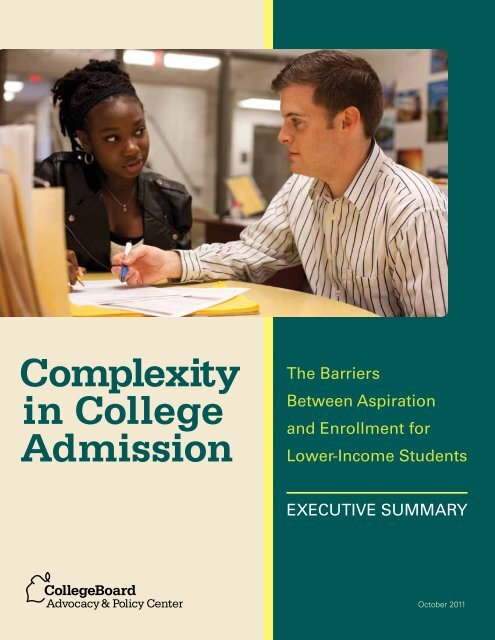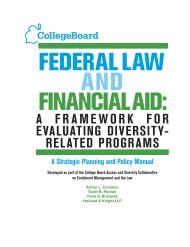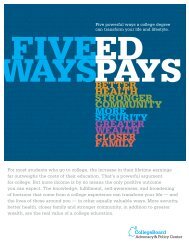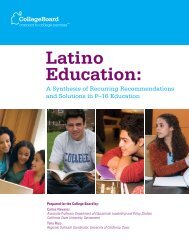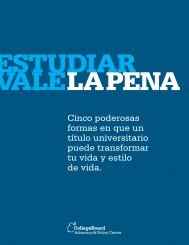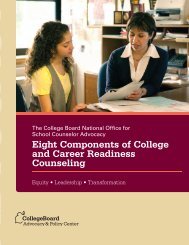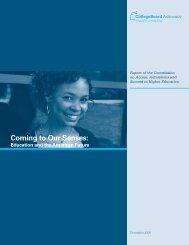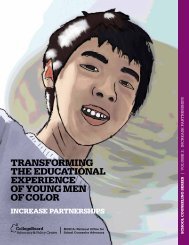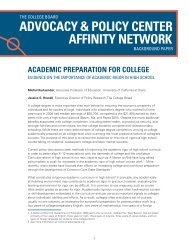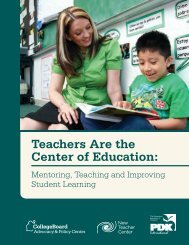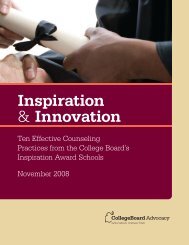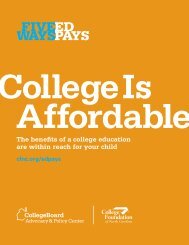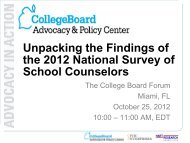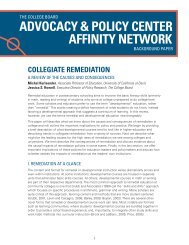Complexity in College Admission: The Barriers Between Aspiration ...
Complexity in College Admission: The Barriers Between Aspiration ...
Complexity in College Admission: The Barriers Between Aspiration ...
You also want an ePaper? Increase the reach of your titles
YUMPU automatically turns print PDFs into web optimized ePapers that Google loves.
<strong>Complexity</strong><br />
<strong>in</strong> <strong>College</strong><br />
<strong>Admission</strong><br />
<strong>The</strong> <strong>Barriers</strong><br />
<strong>Between</strong> <strong>Aspiration</strong><br />
and Enrollment for<br />
Lower-Income Students<br />
Executive Summary<br />
October 2011
About the <strong>College</strong> Board<br />
<strong>The</strong> <strong>College</strong> Board is a mission-driven not-for-profit<br />
organization that connects students to college success<br />
and opportunity. Founded <strong>in</strong> 1900, the <strong>College</strong> Board<br />
was created to expand access to higher education.<br />
Today, the membership association is made up of<br />
more than 5,900 of the world’s lead<strong>in</strong>g educational<br />
<strong>in</strong>stitutions and is dedicated to promot<strong>in</strong>g excellence<br />
and equity <strong>in</strong> education. Each year, the <strong>College</strong> Board<br />
helps more than seven million students prepare for<br />
a successful transition to college through programs<br />
and services <strong>in</strong> college read<strong>in</strong>ess and college success<br />
— <strong>in</strong>clud<strong>in</strong>g the SAT ® and the Advanced Placement<br />
Program ® . <strong>The</strong> organization also serves the education<br />
community through research and advocacy on behalf of<br />
students, educators and schools.<br />
<strong>The</strong> <strong>College</strong> Board Advocacy &<br />
Policy Center<br />
<strong>The</strong> <strong>College</strong> Board Advocacy & Policy Center was<br />
established to transform education <strong>in</strong> America. Guided<br />
by the <strong>College</strong> Board’s pr<strong>in</strong>ciples of excellence and<br />
equity <strong>in</strong> education, we work to ensure that students<br />
from all backgrounds have the opportunity to succeed<br />
<strong>in</strong> college and beyond. We make critical connections<br />
between policy, research and real-world practice to<br />
develop <strong>in</strong>novative solutions to the most press<strong>in</strong>g<br />
challenges <strong>in</strong> education today.<br />
For further <strong>in</strong>formation, visit advocacy.collegeboard.org.<br />
For further <strong>in</strong>formation, visit www.collegeboard.org.<br />
<strong>Admission</strong>s <strong>in</strong> the 21st Century Task Force Implementation Committee<br />
Chair:<br />
Bruce Walker<br />
<strong>The</strong> University of Texas at Aust<strong>in</strong><br />
Implementation Committee Members:<br />
John Barnhill<br />
Barbara A. Gill<br />
Florida State University University of Maryland<br />
Joyce Brown<br />
Chicago Public Schools<br />
Arlene W. Cash<br />
Spelman <strong>College</strong><br />
Randall C. Deike<br />
New York University<br />
Michael R. He<strong>in</strong>tze<br />
Texas State University<br />
Robert Lay<br />
Boston <strong>College</strong><br />
Chat Leonard<br />
Metro Academic &<br />
Classical High School<br />
Jerome A. Lucido<br />
University of Southern<br />
California<br />
Richard H. Shaw<br />
Stanford University<br />
Joellen L. Silberman<br />
Kalamazoo <strong>College</strong><br />
Gordon E. Stanley<br />
<strong>The</strong> Marist School<br />
Lloyd Thacker<br />
<strong>The</strong> Education<br />
Conservancy<br />
© 2011 <strong>The</strong> <strong>College</strong> Board. <strong>College</strong> Board, Advanced Placement Program, SAT and the acorn logo are registered trademarks of the <strong>College</strong> Board.<br />
<strong>College</strong>Keys Compact is a trademark owned by the <strong>College</strong> Board. All other products and services may be trademarks of their respective owners.<br />
Visit the <strong>College</strong> Board on the Web: www.collegeboard.org.<br />
Editorial assistance and design: KSA-Plus Communications
Reduc<strong>in</strong>g the <strong>Complexity</strong> of<br />
<strong>College</strong> <strong>Admission</strong><br />
<strong>The</strong> <strong>College</strong> Board conducted this research to answer three primary questions:<br />
■■<br />
Do lower-<strong>in</strong>come students and their parents f<strong>in</strong>d the college<br />
application process overly complex?<br />
■■<br />
If so, what particular barriers get <strong>in</strong> the way of apply<strong>in</strong>g or<br />
enroll<strong>in</strong>g? Lack of understand<strong>in</strong>g? Lack of confidence? Other<br />
obstacles?<br />
■■<br />
What issues or people have the biggest <strong>in</strong>fluence on their<br />
decisions?<br />
Telephone <strong>in</strong>terviews were conducted <strong>in</strong> April 2011 with 604 lower-<strong>in</strong>come<br />
students (household <strong>in</strong>come equal to or less than $60,000) who took the SAT;<br />
100 higher-<strong>in</strong>come students (household <strong>in</strong>come above $60,000) who took the<br />
SAT; and 100 lower-<strong>in</strong>come parents of students who took the SAT. <strong>The</strong> marg<strong>in</strong><br />
of error was +/– 3.4 percent at the 95 percent confidence level.<br />
This research follows our <strong>in</strong>itial October 2010 report (<strong>Complexity</strong> <strong>in</strong> <strong>College</strong><br />
<strong>Admission</strong>: Fact or Urban Myth), which found that, contrary to conventional<br />
wisdom, students and parents do not f<strong>in</strong>d the college application process<br />
overly complex.<br />
<strong>The</strong>se surveys are part of the <strong>College</strong> Board’s broader, multiyear effort to<br />
strengthen the transition from high school to college, which is be<strong>in</strong>g overseen<br />
by the 14-member <strong>Admission</strong>s <strong>in</strong> the 21st Century Task Force Implementation<br />
Committee. Our f<strong>in</strong>d<strong>in</strong>gs and recommendations are designed for admission,<br />
f<strong>in</strong>ancial aid, enrollment and counsel<strong>in</strong>g professionals.<br />
<strong>Admission</strong> Is Stressful,<br />
but Not Too Complex<br />
<strong>Complexity</strong> <strong>in</strong> <strong>College</strong> <strong>Admission</strong>:<br />
Fact or Urban Myth<br />
Research F<strong>in</strong>d<strong>in</strong>gs of Parent and<br />
Student Perceptions of <strong>Complexity</strong><br />
<strong>in</strong> <strong>College</strong> <strong>Admission</strong><br />
Commissioned by the Task Force<br />
on <strong>Admission</strong>s <strong>in</strong> the 21st Century<br />
October 2010<br />
Our first report <strong>in</strong> this series,<br />
<strong>Complexity</strong> <strong>in</strong> <strong>College</strong><br />
<strong>Admission</strong>: Fact or Urban<br />
Myth (October 2010), found<br />
that apply<strong>in</strong>g to college was a<br />
fairly straightforward (though<br />
moderately stressful) process<br />
for students and parents.<br />
<strong>Complexity</strong> and stress for<br />
students and parents alike<br />
<strong>in</strong>creased as the number of<br />
applications rose. Other key<br />
f<strong>in</strong>d<strong>in</strong>gs can be found on the<br />
<strong>College</strong> Board website.<br />
<strong>The</strong> <strong>College</strong> Board n 1
1<br />
Lower-<strong>in</strong>come students have similar or higher aspirations than<br />
higher-<strong>in</strong>come students to attend college and are confident about<br />
navigat<strong>in</strong>g the college admission process.<br />
F<strong>in</strong>d<strong>in</strong>gs<br />
Lower-<strong>in</strong>come students:<br />
■■<br />
Are much more likely than higher-<strong>in</strong>come students<br />
(48 percent to 36 percent) to strongly agree that a<br />
college degree is needed “to be successful <strong>in</strong> life.”<br />
■■<br />
Understand their options after high school and are<br />
just as likely as their higher-<strong>in</strong>come peers to rate a<br />
four-year college as their top postsecondary option<br />
and to believe that a “prestigious” four-year college<br />
is better than a “typical” one.<br />
■■<br />
Are more likely than their higher-<strong>in</strong>come peers to<br />
strongly disagree that start<strong>in</strong>g at a two-year college<br />
and transferr<strong>in</strong>g to a four-year college is just as good<br />
as attend<strong>in</strong>g a four-year college from the beg<strong>in</strong>n<strong>in</strong>g.<br />
■■<br />
Have similar estimates to those of higher-<strong>in</strong>come<br />
students about first-year college costs and are<br />
equally likely to understand that these costs <strong>in</strong>clude<br />
room and board <strong>in</strong> addition to tuition.<br />
Recommendations<br />
High schools and colleges should offer consistent<br />
support and follow-up to lower-<strong>in</strong>come students to help<br />
ensure that college aspirations actually lead to college<br />
enrollment. For example:<br />
■■<br />
High-school-sponsored college <strong>in</strong>formation days/<br />
nights, <strong>in</strong>clud<strong>in</strong>g the <strong>in</strong>volvement of parents;<br />
■■<br />
<strong>College</strong> outreach and recruitment visits to<br />
underserved secondary schools;<br />
■■<br />
Well-developed college and university <strong>in</strong>formational<br />
websites;<br />
■■<br />
Encouragement of early college options, <strong>in</strong>clud<strong>in</strong>g<br />
community college; and<br />
■■<br />
Participation of schools and colleges <strong>in</strong> the<br />
<strong>College</strong>Keys Compact.<br />
■■<br />
Despite hav<strong>in</strong>g similarly strong college aspirations,<br />
experience more substantial “melt” between<br />
aspiration and enrollment than their higher-<strong>in</strong>come<br />
peers, accord<strong>in</strong>g to previous studies. This suggests a<br />
topic for further exploration.<br />
Students agree that “You need a college degree to be successful <strong>in</strong> life.”<br />
Lower-<strong>in</strong>come students<br />
10% 13% 28% 48%<br />
Higher-<strong>in</strong>come students 7% 19%<br />
38% 36%<br />
Strongly disagree<br />
Somewhat disagree Somewhat agree Strongly agree<br />
2 n <strong>Complexity</strong> <strong>in</strong> <strong>College</strong> <strong>Admission</strong>: <strong>The</strong> <strong>Barriers</strong> <strong>Between</strong> <strong>Aspiration</strong> and Enrollment for Lower-Income Students
Students agree that “It doesn’t matter whether you go to a community college for two<br />
years and then f<strong>in</strong>ish at a four-year college or go to a four-year college the whole time.”<br />
Lower-<strong>in</strong>come students<br />
9% 16% 36% 39%<br />
Higher-<strong>in</strong>come students 4% 21%<br />
35% 41%<br />
Strongly disagree<br />
Somewhat disagree Somewhat agree Strongly agree<br />
Mean rat<strong>in</strong>gs of options after graduat<strong>in</strong>g high school<br />
Go<strong>in</strong>g to a prestigious four-year college that is hard to get <strong>in</strong>to<br />
Go<strong>in</strong>g to a typical four-year college that is not hard to get <strong>in</strong>to<br />
7.6<br />
7.8<br />
7.3<br />
7.4<br />
Go<strong>in</strong>g to a community college<br />
5.9<br />
5.7<br />
Work<strong>in</strong>g full-time<br />
4.4<br />
5.2<br />
Jo<strong>in</strong><strong>in</strong>g the military<br />
4.8<br />
4.9<br />
Lower-<strong>in</strong>come students<br />
Higher-<strong>in</strong>come students<br />
<strong>College</strong> aspirations reported <strong>in</strong> study compared to enrollment patterns from<br />
previous studies<br />
Plans reported <strong>in</strong> current study<br />
Lower-<strong>in</strong>come<br />
students<br />
Higher-<strong>in</strong>come<br />
students<br />
2009 SAT takers’ actual behavior<br />
Lower-<strong>in</strong>come<br />
students<br />
Higher-<strong>in</strong>come<br />
students<br />
Any college 93% 97% 75% 86%<br />
Two-year 21% 15% 27% 20%<br />
Four-year 72% 82% 48% 66%<br />
No college 7% 3% 25% 14%<br />
<strong>The</strong> <strong>College</strong> Board n 3
2<br />
Although both lower- and higher-<strong>in</strong>come students say they receive<br />
plenty of <strong>in</strong>formation from colleges, lower-<strong>in</strong>come students are<br />
more likely to report be<strong>in</strong>g <strong>in</strong>fluenced by it.<br />
F<strong>in</strong>d<strong>in</strong>gs<br />
Lower-<strong>in</strong>come students:<br />
■■<br />
Like their higher-<strong>in</strong>come peers, say they received<br />
pr<strong>in</strong>t or email advertisements from four-year<br />
colleges (94 percent of lower-<strong>in</strong>come students and<br />
90 percent of higher-<strong>in</strong>come students).<br />
■■<br />
Are 12 percentage po<strong>in</strong>ts more likely to report us<strong>in</strong>g<br />
the <strong>in</strong>formation from pr<strong>in</strong>t or email advertisements<br />
to apply to a school they had not previously<br />
considered.<br />
■■<br />
Are more likely than their higher-<strong>in</strong>come peers to<br />
mention <strong>in</strong>dividual colleges’ websites (44 percent<br />
to 32 percent) and college search sites (42 percent<br />
to 24 percent) as “very <strong>in</strong>fluential” <strong>in</strong>formation<br />
sources.<br />
Recommendations<br />
<strong>College</strong>s should create or repurpose <strong>in</strong>formational<br />
resources that target lower-<strong>in</strong>come students and their<br />
concerns. Secondary schools should po<strong>in</strong>t students<br />
to a wide variety of <strong>in</strong>formation sources <strong>in</strong> the college<br />
search and selection process. For example:<br />
■■<br />
Expansion of targeted and highly segmented<br />
outreach and recruitment messag<strong>in</strong>g;<br />
■■<br />
Early outreach to students and their parents;<br />
■■<br />
Outreach materials that address the specific <strong>in</strong>terests<br />
and concerns of lower-<strong>in</strong>come students relat<strong>in</strong>g to<br />
affordability and the availability of f<strong>in</strong>ancial aid; and<br />
■■<br />
Improved student access to well-developed<br />
noncommercial, secondary <strong>in</strong>formation sources,<br />
such as onl<strong>in</strong>e college plann<strong>in</strong>g sites.<br />
Pr<strong>in</strong>t or email advertisements caused students to apply to schools they might not have<br />
considered before<br />
1%<br />
Lower-<strong>in</strong>come students<br />
6%<br />
58%<br />
35%<br />
2%<br />
Higher-<strong>in</strong>come students 8%<br />
67%<br />
23%<br />
Don’t know if received<br />
Didn’t receive<br />
Don’t know No Yes<br />
Advis<strong>in</strong>g Counts<br />
In addition to the importance of <strong>in</strong>formation provided by colleges, other studies have <strong>in</strong>vestigated the effectiveness<br />
of personal contact. <strong>The</strong> National <strong>College</strong> Advis<strong>in</strong>g Corps places tra<strong>in</strong>ed, recent college graduates <strong>in</strong> high schools<br />
to counsel low-<strong>in</strong>come and first-generation students as they navigate the college process. Schools served by this<br />
program saw an 8 to 12 percentage po<strong>in</strong>t <strong>in</strong>crease <strong>in</strong> college-go<strong>in</strong>g rates compared to a control group of similar<br />
schools <strong>in</strong> the area (www.advis<strong>in</strong>gcorps.org/success-results).<br />
4 n <strong>Complexity</strong> <strong>in</strong> <strong>College</strong> <strong>Admission</strong>: <strong>The</strong> <strong>Barriers</strong> <strong>Between</strong> <strong>Aspiration</strong> and Enrollment for Lower-Income Students
Friends<br />
<strong>College</strong> guides<br />
3<br />
Lower-<strong>in</strong>come students especially value personal support from<br />
guidance counselors, teachers, college alumni and college<br />
representatives <strong>in</strong> decid<strong>in</strong>g where to apply.<br />
Parents<br />
F<strong>in</strong>d<strong>in</strong>gs<br />
Recommendations<br />
50%<br />
57%<br />
Lower-<strong>in</strong>come students:<br />
Secondary schools should expand support for school<br />
counselors and Individual programs websites that educate of colleges lower-<strong>in</strong>come<br />
■■<br />
Like higher-<strong>in</strong>come students, say parents and<br />
college websites are their most <strong>in</strong>fluential sources of<br />
college <strong>in</strong>formation.<br />
■■<br />
Are more likely to s<strong>in</strong>gle out high school guidance<br />
counselors (41 percent to 28 percent), teachers<br />
(35 percent to 14 percent) and other adults <strong>in</strong> the<br />
community (16 percent to 8 percent) as “very<br />
students about the requirements for college 44% success.<br />
<strong>College</strong>s and universities should develop 32% a multifaceted<br />
approach for personaliz<strong>in</strong>g their messages to students.<br />
For example: <strong>College</strong> search sites<br />
42%<br />
■■<br />
School district endorsement 24% of programs such as<br />
the National Office for School Counselor Advocacy’s<br />
Eight Components<br />
High school<br />
of <strong>College</strong><br />
guidance<br />
and<br />
counselors<br />
Career Read<strong>in</strong>ess<br />
<strong>in</strong>fluential.”<br />
Counsel<strong>in</strong>g;<br />
41%<br />
28%<br />
■■<br />
Value this “high-touch,” personal approach —<br />
■■<br />
Profiles of successful lower-<strong>in</strong>come students and<br />
especially those lower-<strong>in</strong>come students Parents with the<br />
graduates <strong>in</strong> Teachers college outreach materials;<br />
lowest SAT scores.<br />
50%<br />
35%<br />
■■<br />
On-campus 57% programs 14% to address the specific<br />
■■<br />
Say they would have been much more likely to<br />
<strong>in</strong>terests and needs of lower-<strong>in</strong>come and firstgeneration<br />
students; <strong>Admission</strong> staff at the colleges<br />
apply to a four-year college or a more selective Individual websites of colleges<br />
four-year college if they could have met successful<br />
44%<br />
31%<br />
alumni like them (62 percent) or if a college<br />
■32%<br />
■ Information targeted to parents; 25% and<br />
representative had reached out to them personally<br />
(60 percent).<br />
<strong>College</strong> search sites ■■<br />
Peer counsel<strong>in</strong>g Other support family members to help lower-<strong>in</strong>come<br />
applicants 42% f<strong>in</strong>d an appropriate 27% college “match.”<br />
24%<br />
31%<br />
High school guidance counselors Friends<br />
41%<br />
28%<br />
“Very <strong>in</strong>fluential” sources of <strong>in</strong>formation about where to apply<br />
27%<br />
21%<br />
Parents<br />
50%<br />
57%<br />
Teachers<br />
14%<br />
35%<br />
Catalogs, viewbooks or other pr<strong>in</strong>t materials<br />
19%<br />
14%<br />
Individual websites of colleges<br />
32%<br />
44%<br />
<strong>Admission</strong> staff at the colleges<br />
31%<br />
25%<br />
Other adults <strong>in</strong> community, church, etc.<br />
16%<br />
8%<br />
<strong>College</strong> search sites<br />
24%<br />
42%<br />
Other family members<br />
27%<br />
31%<br />
Coaches<br />
14%<br />
12%<br />
High school guidance counselors<br />
28%<br />
41%<br />
Friends<br />
27%<br />
21%<br />
<strong>College</strong> guides<br />
8%<br />
9%<br />
Lower-<strong>in</strong>come students<br />
Higher-<strong>in</strong>come students<br />
Teachers<br />
14%<br />
35%<br />
Catalogs, viewbooks or other pr<strong>in</strong>t materials<br />
19%<br />
14%<br />
<strong>Admission</strong> staff at the colleges<br />
31%<br />
25%<br />
Other family members<br />
27%<br />
31%<br />
Other adults <strong>in</strong> community, church, etc.<br />
16%<br />
8%<br />
Coaches<br />
14%<br />
12%<br />
<strong>The</strong> <strong>College</strong> Board n 5
4<br />
Not surpris<strong>in</strong>gly, lower-<strong>in</strong>come students are more likely to be<br />
concerned about costs than higher-<strong>in</strong>come students.<br />
F<strong>in</strong>d<strong>in</strong>gs<br />
Lower-<strong>in</strong>come students:<br />
■■<br />
Are much more likely than their higher-<strong>in</strong>come<br />
peers to take f<strong>in</strong>ancial aid <strong>in</strong>to account (77 percent<br />
to 52 percent) when look<strong>in</strong>g at the cost of college.<br />
■■<br />
Are about three times less likely than higher-<strong>in</strong>come<br />
students (6 percent to 17 percent) to say they “can<br />
afford almost any college without much hardship.”<br />
■■<br />
Are half as likely (23 percent to 46 percent) to say<br />
they “can afford most colleges if we stretch a bit.”<br />
Recommendations<br />
As more lower-<strong>in</strong>come and m<strong>in</strong>ority students apply to<br />
college, higher education <strong>in</strong>stitutions need to create<br />
f<strong>in</strong>ancial aid and assistance policies that will open<br />
access to all students. For example:<br />
■■<br />
Tools to help families understand the cost of<br />
education early <strong>in</strong> the process;<br />
■■<br />
Support for susta<strong>in</strong><strong>in</strong>g the Pell Grant program;<br />
■■<br />
A simpler f<strong>in</strong>ancial aid application process,<br />
especially for the federal application; and<br />
■■<br />
Cont<strong>in</strong>ued efforts to provide clear and concise<br />
<strong>in</strong>formation about college costs and the availability<br />
of f<strong>in</strong>ancial aid, <strong>in</strong>clud<strong>in</strong>g plans that reduce loan<br />
burdens for lower-<strong>in</strong>come students.<br />
Pay<strong>in</strong>g for college<br />
Lower-<strong>in</strong>come students Lower-<strong>in</strong>come 17% students 21% 17% 33% 21% 23% 33% 6%<br />
23%<br />
6%<br />
Higher-<strong>in</strong>come students Higher-<strong>in</strong>come 7% 5% students 25%<br />
7% 5%<br />
46% 25%<br />
17% 46%<br />
17%<br />
Can’t afford, but<br />
are go<strong>in</strong>g<br />
to try anyway<br />
Can’t Not afford, sure how but we<br />
are will go<strong>in</strong>g afford, but<br />
to try believe anyway we’ll work<br />
someth<strong>in</strong>g out<br />
Not sure Will how have we to stretch Will have Can to afford stretch most<br />
will afford, a lot to but afford, but a lot to colleges, afford, but if we<br />
believe th<strong>in</strong>k we’ll we’ll work make it th<strong>in</strong>k we’ll stretch make a bit<br />
someth<strong>in</strong>g out<br />
Can Can afford almost Can afford almost<br />
colleges, any college if we without any college without<br />
stretch much a hardship bit much hardship<br />
6 n <strong>Complexity</strong> <strong>in</strong> <strong>College</strong> <strong>Admission</strong>: <strong>The</strong> <strong>Barriers</strong> <strong>Between</strong> <strong>Aspiration</strong> and Enrollment for Lower-Income Students
5<br />
Lower-<strong>in</strong>come students are likely to apply to fewer colleges than<br />
higher-<strong>in</strong>come students.<br />
F<strong>in</strong>d<strong>in</strong>gs<br />
Lower-<strong>in</strong>come students:<br />
■■<br />
On average, apply to fewer colleges than higher<strong>in</strong>come<br />
students (mean of 3.4 to 3.9 applications).<br />
■■<br />
Apply to fewer colleges, particularly those lower<strong>in</strong>come<br />
students whose SAT scores are <strong>in</strong> the middle<br />
and low ranges (mean of 3.2 applications).<br />
Recommendations<br />
In addition to help<strong>in</strong>g lower-<strong>in</strong>come students f<strong>in</strong>d<br />
colleges that are a good fit, both secondary schools and<br />
colleges should encourage these students to apply to<br />
slightly more colleges. For example:<br />
■■<br />
Appropriate use of common applications as<br />
an effective tool to broaden a student’s set of<br />
postsecondary choices; and<br />
■ ■ Endorsement of and support for national <strong>in</strong>itiatives<br />
such as National <strong>College</strong> Application Week.<br />
Mean number of schools applied to<br />
Lower-<strong>in</strong>come students<br />
3.4<br />
Higher-<strong>in</strong>come students<br />
3.9<br />
Mean number of schools lower-<strong>in</strong>come<br />
students applied to — by SAT scores<br />
High SAT score (1100 or higher)<br />
Middle SAT score (910–1090)<br />
3.2<br />
3.9<br />
Low SAT score (900 or lower)<br />
3.2<br />
More than one Application = Higher Enrollment<br />
Research by the <strong>College</strong> Board Advocacy & Policy Center shows that <strong>in</strong>creas<strong>in</strong>g the number of applications<br />
a student submits significantly <strong>in</strong>creases the probability of college enrollment. Students who apply to two<br />
colleges are 40 percent more likely to enroll than those who apply to only one. Increas<strong>in</strong>g from two to three<br />
applications boosts the probability of enroll<strong>in</strong>g by 10 percent. This effect dim<strong>in</strong>ishes beyond three applications<br />
and is strongest for lower-<strong>in</strong>come students (http://admissions21.collegeboard.org).<br />
<strong>The</strong> <strong>College</strong> Board n 7
6<br />
Lower-<strong>in</strong>come students and parents are <strong>in</strong> sync on many issues,<br />
but there are exceptions.<br />
F<strong>in</strong>d<strong>in</strong>gs<br />
Parents of lower-<strong>in</strong>come students:<br />
■■<br />
Are just as likely as lower-<strong>in</strong>come students to<br />
consider f<strong>in</strong>ancial aid <strong>in</strong>tegral to college enrollment<br />
and to welcome support from guidance counselors<br />
and extra tutor<strong>in</strong>g.<br />
■■<br />
Are even more likely than lower-<strong>in</strong>come students<br />
to value a college degree (87 percent to 76 percent)<br />
and to assume their children will attend college<br />
(98 percent to 93 percent).<br />
■■<br />
Are much more optimistic that their children could<br />
have gotten <strong>in</strong>to more selective colleges (82 percent<br />
of lower-<strong>in</strong>come parents to 66 percent of lower<strong>in</strong>come<br />
students), but are much less likely to have<br />
considered such colleges (74 percent of lower<strong>in</strong>come<br />
parents say they did not consider such<br />
colleges compared to 52 percent of lower-<strong>in</strong>come<br />
students).<br />
Recommendations<br />
Like parents <strong>in</strong> all <strong>in</strong>come groups, lower-<strong>in</strong>come parents<br />
<strong>in</strong>fluence their children’s college choices to vary<strong>in</strong>g<br />
degrees. However, lower-<strong>in</strong>come parents have some<br />
special needs that secondary schools and colleges<br />
should address. For example:<br />
■■<br />
Early availability of <strong>in</strong>formation about the f<strong>in</strong>ancial<br />
aid and college admission processes through<br />
outreach events, campus visits, <strong>in</strong>formation sessions<br />
and the like;<br />
■■<br />
Support for school counselors to provide assistance<br />
to lower-<strong>in</strong>come parents; and<br />
■■<br />
Targeted outreach and campus programs that<br />
address the special needs and concerns of lower<strong>in</strong>come<br />
parents.<br />
■■<br />
Are much more likely than lower-<strong>in</strong>come or higher<strong>in</strong>come<br />
students to say that they helped <strong>in</strong> the<br />
college admission process.<br />
■■<br />
Are less likely (32 percent) than lower-<strong>in</strong>come<br />
students (53 percent) and higher-<strong>in</strong>come students<br />
(38 percent) to say the application decision was<br />
“completely the child’s.”<br />
Ways parents have supported students’ college search and decision-mak<strong>in</strong>g process<br />
Figured out how to pay for college<br />
Paid for materials/courses to prepare for SAT/ACT<br />
Visited colleges <strong>in</strong>terested <strong>in</strong><br />
Decided which college is best<br />
Researched colleges might be <strong>in</strong>terested <strong>in</strong><br />
54%<br />
Filled out and submitted college applications<br />
54%<br />
60%<br />
64%<br />
67%<br />
67%<br />
70%<br />
74%<br />
79%<br />
83%<br />
81%<br />
90%<br />
Lower-<strong>in</strong>come students<br />
Parents of lower-<strong>in</strong>come students<br />
8 n <strong>Complexity</strong> <strong>in</strong> <strong>College</strong> <strong>Admission</strong>: <strong>The</strong> <strong>Barriers</strong> <strong>Between</strong> <strong>Aspiration</strong> and Enrollment for Lower-Income Students
Elim<strong>in</strong>at<strong>in</strong>g <strong>Barriers</strong> to Higher<br />
Education <strong>in</strong> the <strong>Admission</strong> Process:<br />
What’s Next?<br />
<strong>The</strong> <strong>College</strong> Board believes that to atta<strong>in</strong> a goal of 55<br />
percent of our nation’s youth achiev<strong>in</strong>g a postsecondary<br />
credential by 2025, access to and success <strong>in</strong> college are<br />
critical for all students, regardless of their background.<br />
Identify<strong>in</strong>g barriers <strong>in</strong> the admission process —<br />
especially for lower-<strong>in</strong>come students — is critical to<br />
creat<strong>in</strong>g policies and practices that open access to<br />
higher education.<br />
As noted <strong>in</strong> this body of research on complexity <strong>in</strong><br />
admission, we now have a clearer sense of what<br />
factors are and are not barriers and how to respond<br />
to them. <strong>The</strong> research also suggests other areas that<br />
may warrant future exploration, <strong>in</strong>clud<strong>in</strong>g the “melt”<br />
that occurs with so many students who have applied<br />
to colleges and completed the application process<br />
but do not enroll the follow<strong>in</strong>g fall. Another l<strong>in</strong>e of<br />
<strong>in</strong>quiry could <strong>in</strong>vestigate the factors or barriers <strong>in</strong><br />
the admission process that prevent students from<br />
beg<strong>in</strong>n<strong>in</strong>g the application process or cause students<br />
to end it prematurely. Understand<strong>in</strong>g all these factors<br />
will help us make the connections between realworld<br />
experiences and policy evolution that result<br />
<strong>in</strong> <strong>in</strong>novative solutions to the challenges fac<strong>in</strong>g our<br />
education system today.<br />
<strong>The</strong> Task Force on <strong>Admission</strong>s <strong>in</strong> the 21st Century<br />
is committed to elim<strong>in</strong>at<strong>in</strong>g the barriers to college<br />
access and success. <strong>The</strong> results of this research and<br />
its recommendations will be widely shared with<br />
the admission, school counsel<strong>in</strong>g and f<strong>in</strong>ancial aid<br />
communities most closely associated with the transition<br />
from school to college and with policymakers who will<br />
make the changes necessary to facilitate access.<br />
<strong>The</strong> <strong>College</strong> Board n 9
advocacy.collegeboard.org<br />
#11b-4101 110344637


